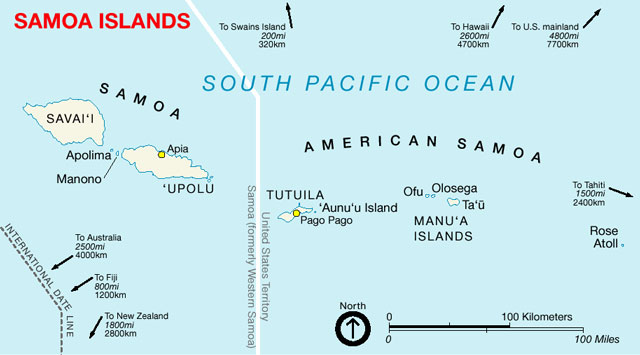
The integration of marine data in geographic information systems (GIS) provides a means for advancing marine and coastal research, science and management, geo-referenced mapping, modeling and decision making (e.g., Wright and Bartlett 2000, Valavanis 2002). Geo-referenced habitat-species maps and habitat assessments are essential to marine habitat management (NOAA: USDOC 2002).

The coral reef ecosystems around American Samoa are being threatened by natural and adverse anthropogenic patterns and processes (Evans et al. 2002). Examples of natural threats are coral bleaching, infestation of Crown-of-Thorns starfish and frequent tropical cyclones (Craig 2002, FBNMS 2004, FEMA 2004). Anthropogenic threats such as gill netting, spear fishing, poison and dynamite fishing, non-point pollution and cumulative impacts challenge and stunt coral reef recovery from natural disasters (ASG: DOC 2004).
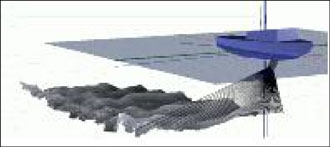
The first scientific surveys of moderate depth (30-150 m) coral reef ecosystems around American Samoa collected bathymetric data from ~3 to 160 m depth in 2001 and 2002 with the University of South Florida's Kongsberg Simrad EM3000, 300 kHz, multibeam mapping system (Wright et al. 2002, Wright 2002). The 2001 survey collected bathymetry and backscatter for Fagatele Bay National Marine Sanctuary (FBNMS), part of the National Park, Pago Pago Harbor, the western portion of Taema Bank, and Faga'itua Bay (Figure 3). Sites surveyed in November 2002 are eastern Taema Bank, Coconut Point, Fagatele Bay, and Vatia Bay (Figure 3). This paper focuses on FBNMS.
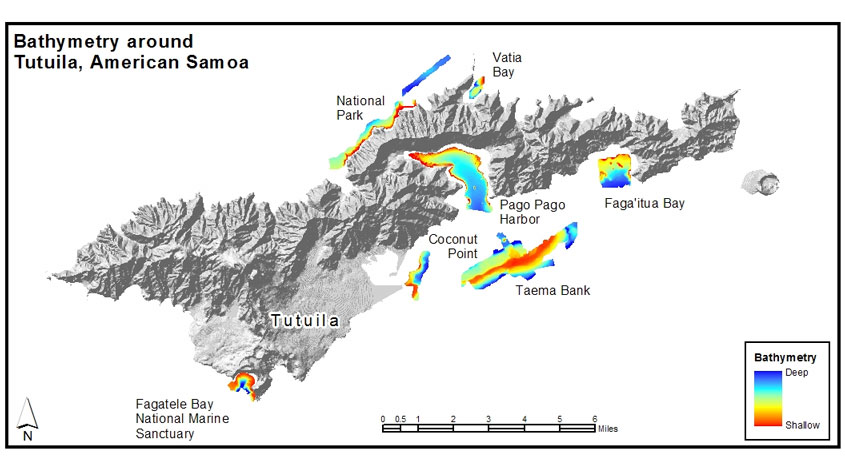
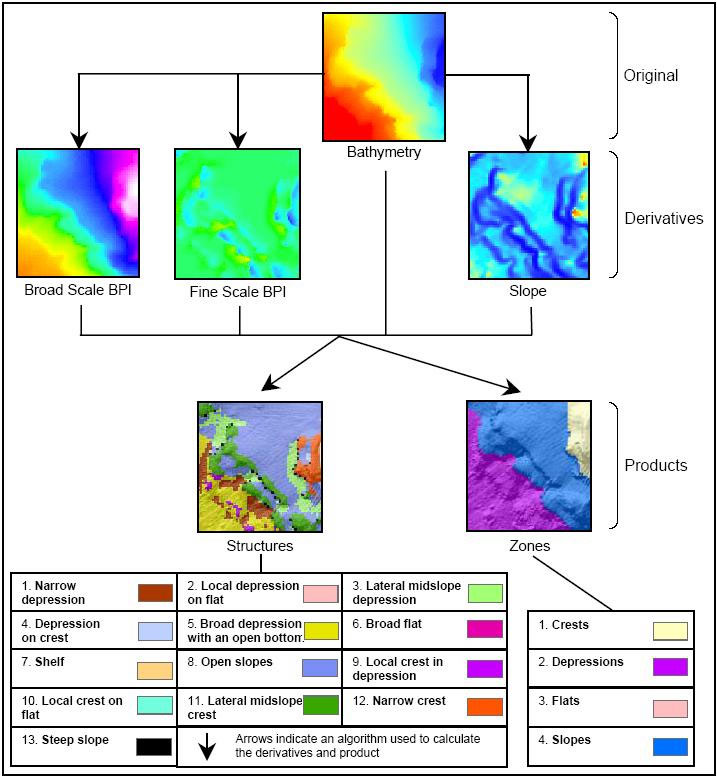
Multiple schemes were reviewed for classifications around American Samoa (Coops et al. 1998, Dartnell and Gardner (in press), Greene et al. 1999, Iampietro and Kvitek 2002, Schmal et al. 2003, Speight 1990, Weiss 2001, Zajac et al. 2003). The NOAA/NOS Biogeography Program developed the first classification scheme for U.S. Pacific Islands. In agreement with the NOAA Mapping Implementation Plan (2003), the scheme needs modification for deeper water classifications. Weiss's (2001) landform classes are another valuable classification scheme. Weiss's study classifies slope position and landform types that are predictors of habitat suitability, community composition, and species distribution. In this study, the landform classes are interpreted to describe the seafloor; these can serve as a baseline for future habitat studies. The terminology used in the classification scheme presented here is well-matched with the NOAA/NOS Biogeography scheme for shallow water classifications around the Main Hawaiian Islands (NOAA: NWHI 2003), which was developed using IKONOS imagery and airborne photographic data. This biogeography scheme is being extended into deeper water by scientists at the Coral Reef Ecosystem Division (CRED) of the Pacific Island Fisheries Science Center, who are working primarily with multibeam and underwater video data (Rooney and Miller pers. comm. 2004) in 20-200m water depths. These NOAA classification schemes, the Weiss (2001) landform scheme, and the Speight (1990) scheme, were closely analyzed to develop agreeable terms for the BPI zones and structures that extend below 30 meters depth around American Samoa.
In this scheme, broad refers to seafloor characteristics defined by broad scale bathymetric position index (BPI) grids and fine refers to seafloor characteristics defined by fine scale BPI grids. BPI is described in more detail in the data analysis section.
Slope, or the measure of steepness, is simply derived. Output slope values (raster grids) are derived for each cell as the maximum rate of change from the cell to its neighbor. BPI measures where a georeferenced location, with a defined elevation, is relative to the overall landscape by evaluating elevation differences between a focal point and the mean elevation of the surrounding cells within a user defined rectangle, annulus, or circle. BPI is a second-order derivative of bathymetry modified from topographic position index as defined in Weiss (2001) and Iampietro and Kvitek (2002).
The cells in the output grid are assigned values within a range of positive and negative numbers (Figure 5). A negative value represents a cell that is lower than its neighboring cells (valleys). A positive value represents a cell that is higher than its neighboring cells (ridges). Extreme numbers represent more extreme benthic features. Flat areas or areas with a constant slope produce near-zero values. The results of BPI are scale dependent; different scales identify fine or broad benthic features. Conclusions about the structure of the overall seascape can be made with spatial analysis by applying an algorithm that combines grids of different scales with slope and bathymetry
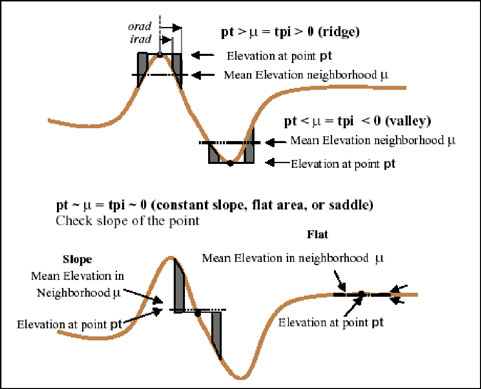
Algorithm 1 creates a BPI grid using bathymetry and user defined radii:
BPI< scalefactor > = int((bathy - focalmean(bathy, annulus, irad, orad)) + .5), where
scalefactor = outer radius in map units
irad = inner radius of annulus in cells
orad = outer radius of annulus in cells
bathy = bathymetric grid
Prior to the classification of the final zones, BPI was standardized by subtracting the mean value and dividing by the standard deviation; the result is multiplied by 100 and then values are converted to integers. The final algorithms for classifying BPI zones and structures are based on combined broad scale and fine scale standardized BPI grids, slope, and depth. In Arc/Info GRID, each of the 13 BPI zones received a unique number as listed in the classification scheme sections. The algorithm uses standard deviation units where 1 standard deviation is 100 grid value units; slope and depth values are defined by the user.
Rugosity classifications extend the classes used by CRED in their 2002 towed- diver surveys. The classes were assigned with the following standard deviation divisions in ArcView® 3.3: Very High (>3 std. dev.), High (2-3 std. dev.), Medium High (1-2 std. dev.), Medium (0-1 std. dev.), Medium Low (Mean), Low (-1-0 std. dev.). Rugosity can be associated with attributes recorded during dives and with comments and attributes recorded in accuracy assessment surveys conducted in 2001 (American Samoa Department of Marine and Wildlife Resources, unpublished data).

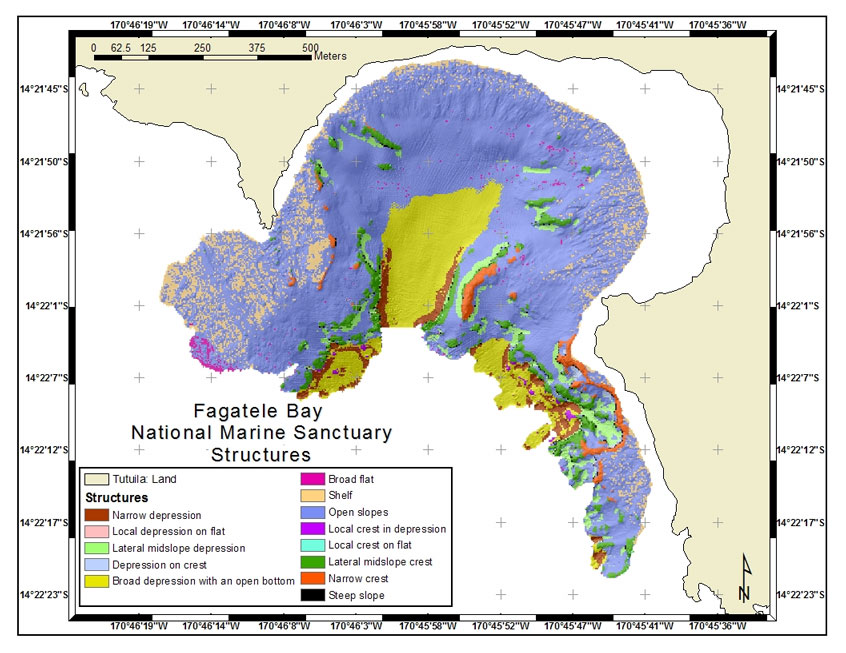
The BPI zones and structures are a baseline of information needed for further studies including submersible surveys that are planned for 2005 (Wright and Naar 2003). They also provide a framework for planning scientific surveys that will give a better understanding of species-habitat relationships and possibly for establishing and monitoring more marine protected areas. The rugosity analysis gives a detailed understanding of where complex features may be hosting high biodiversity (Figure 8). Notice that the highest rugosity values are correlated with the high slope areas and lower rugosity with low slope (Figure 9).
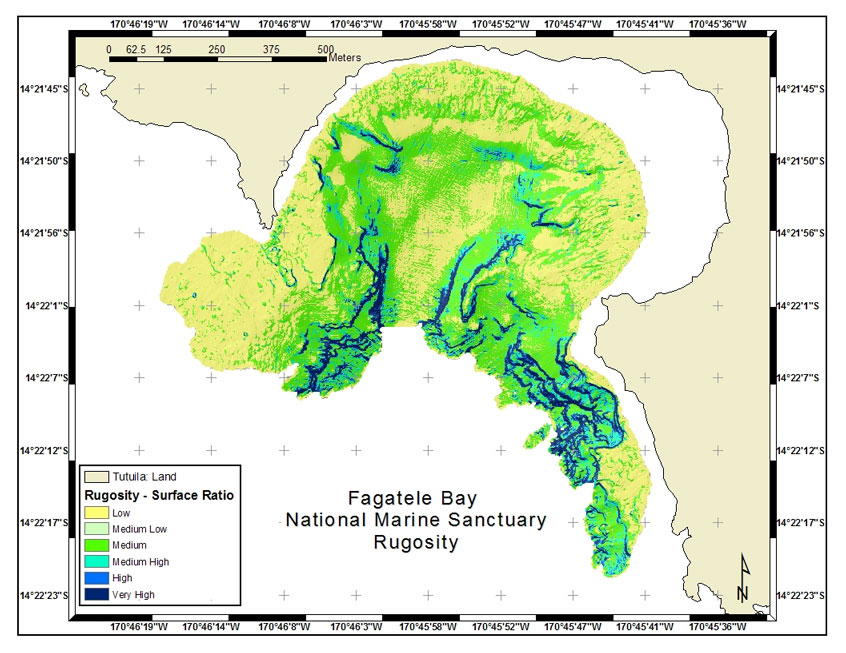
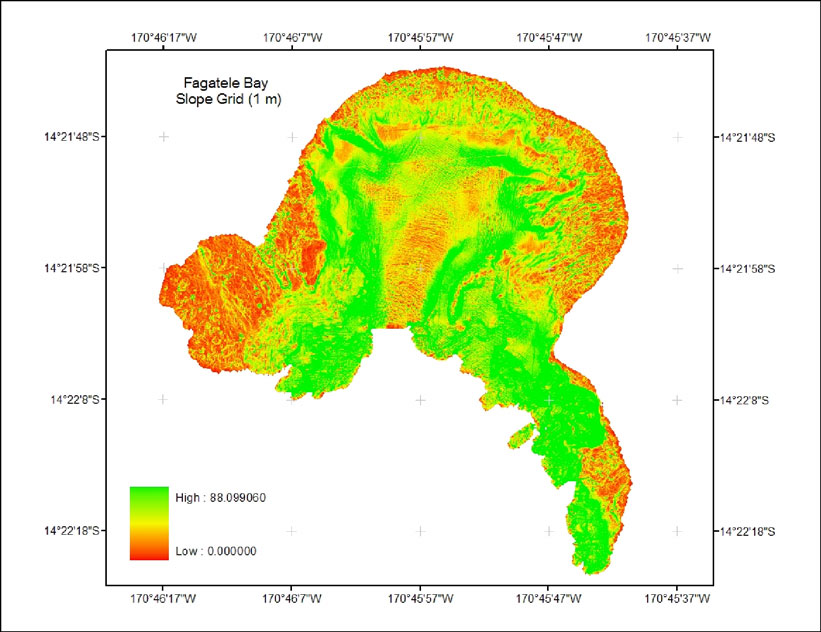
Caress, D.W., Spitzak, S.E., Chayes, D.N., 1996, Software for multibeam sonars, Sea Technology, 37, 54-57.
Coops, N., Ryan, P., Loughhead, A., Mackey, B., Gallant, J., Mullen, I., Austin, M., 1998, Developing and Testing Procedures to Predict Topographic Position from Digital Elevation Models (DEM) for Species Mapping (Phase 1). In CSIRO Forestry and Forest Products: Client Report NO. 271.
Craig, P., 2002, Natural History Guide to American Samoa (Pago Pago, American Samoa: National Park of American Samoa).
Dartnell, P. and Gardner, J. V., in press, Predicting Seafloor Facies from Multibeam Bathymetry and Backscatter Data. In Photogrammetric Engineering and Remote Sensing.
Diaz, J. V. M., 2000, Analysis of Multibeam Sonar Data for the Characterization of Seafloor Habitats. Master of Science Thesis, University of New Brunswick, Fredericton, New Brunswick, Canada.
Evans, D. L., Lautenbacher, C. C. Jr., Mahoney, J. R., Davidson, M. A., 2002, A National Coral Reef Action Strategy. Report to Congress, United States Department of Commerce.
Fagatele Bay National Marine Sanctuary (FBNMS), 2004, Fagatele Bay National Marine Sanctuary Official Site, http://www.fbnms.nos.noaa.gov/HTML/Management.html
Federal Emergency Management Agency (FEMA), 2004, Emergency Managers: National Situation Update - January 2004 Archives, http://www.fema.gov/emanagers/2004/nat010904.shtm
Greene, H.G., Yoklavich, M.M., Starr, R.M., O'Connell, V.M., Wakefield, W.W., Sullivan, D.E., McRea, J.E., Cailliet, G.M., 1999, A Classification Scheme for Deep Seafloor Habitats. Oceanologica Acta, 22(6), 663-678.
Guan, Y. and Flood, R., 2001, Morphologic Analysis of Shinnecock Inlet Using Multibeam Sonar Systems. In Proceedings of the Eighth Conference on the Geology of Long Island and Metropolitan New York, SUNY Stony Brook.
Hall, R.K., Ota, A.Y., Hasimoto, J.Y., 1999, Geographical Information Systems (GIS) to Manage Oceanographic Data for Site Designation and Site Monitoring. Marine Geodesy, 18, 161-171.
Iampietro, P., and Kvitek, R., 2002, Quantitative Seafloor Habitat Classification Using GIS Terrain Analysis: Effects of Data Density, Resolution, and Scale (Conference Poster). (GeoHab 2002).
Jenness, J., 2003, Grid Surface Areas: Surface Area and Ratios from Elevation Grids [Electronic manual]. Jenness Enterprises: ArcView Extensions, http://www.jennessent.com/arcview/arcview_extensions.htm
Lundblad, E., 2004, The Development and Application of Benthic Classifications for Coral Reef Ecosystems Below 30 m Depth using Multibeam Bathymetry: Tutuila, American Samoa. Masters Thesis, Oregon State University, Corvallis, Oregon.
Mayer, L. A., Paton, M., Gee, L., Gardner, J. V., Ware, C., 2000. Interactive 3-D Visualization: A tool for seafloor navigation, exploration and engineering, http://www.ccom-jhc.unh.edu/vislab/PDFs/3DGIS.pdf
Miller, S. L. and Crosby, M. P., 1998, The Extent and Condition of US Coral Reefs. In NOAA's State of the Coast Report. http://state-of-coast.noaa.gov/bulletins/html/crf_08/crf.html
NOAA Biogeography Program (MIP), 2003, Mapping Moderate Depth Habitats of the U.S. Pacific Islands with Emphasis on the Northwestern Hawaiian Islands: an Implementation Plan, v.2, http://biogeo.nos.noaa.gov/projects/mapping
NOAA Biogeography Program (NWHI), 2003. Benthic Habitat Mapping: Northwest Hawaiian Islands Classification Manual, http://biogeo.nos.noaa.gov/projects/mapping/pacific/nwhi/classification/
Rinehart, R., Wright, D., Lundblad, E., Larkin, E., Murphy, J., and Cary-Kothera, L., 2004, ArcGIS 8.x Benthic Terrain Modeler: Analysis in American Samoa. In Proceedings of the 24th Annual ESRI User Conference, San Diego, CA, Paper 1433.
Schmal, ,G.P., Hickerson, E.L, Weaver, D.C., Gardner, J.V., 2003, High-resolution multibeam mapping and habitat characterization of topographic features in the northwestern Gulf of Mexico. In Proceedings of U.S. Hydro 2003 Conference, Biloxi, Mississippi.
Speight, J.G., 1990, Landform. In Australian Soil and Land Survey Field Handbook, 2nd ed. Inkata Press, Melbourne.
Valavanis, V.D., 2002, Geographic Information Systems in Oceanography and Fisheries. (London: Taylor & Francis).
Weiss, A. D., 2001, Topographic Positions and Landforms Analysis (Conference Poster). (San Diego, California: ESRI International User Conference).
Wessel, P., and Smith, W.H.F., 1991, Free software helps map and display data. EOS, Transactions, American Geophysical Union, 72, 293-305.
Wright, D. J., 1996, Rumblings on the Ocean Floor: GIS Supports Deep-Sea Research. Geo Info Systems, 6(1), 22-29.
Wright, D. J., 2002, Mapping the Seafloor in American Samoa. Geospatial Solutions, 12(7): 24-25.
Wright, D.J. and Bartlett, D.J. (editors), 2000, Marine and Coastal Geographical Information Systems. (London: Taylor & Francis).
Wright, D. J. and Naar, D. F., 2003, Travel and Post-Cruise Support for Benthic Mapping in American Samoa, Explore: NOAA Office of Ocean Exploration FY04 Proposal, Oregon.
Wright, D. J., Wood, R., Sylvander, B., 1998, ArcGMT: A suite of tools for conversion between Arc/INFO and Generic Mapping Tools (GMT). Computers and Geosciences, 24(8), 737-744.
Wright, D. J., Donahue, B. T., and Naar, D. F., 2002, Seafloor Mapping and GIS Coordination at America's Remotest National Marine Sanctuary (American Samoa). In Undersea with GIS, edited by Dawn J. Wright. (Redlands, CA: ESRI Press), 33-63.
Zajac, R.N., Lewis, R.S., Poppe, L.J., Twichell, D.C., Vozarik, J., DiGiacomo-Cohen, M.L., 2003, Responses of infaunal populations to benthoscape structure and potential importance of transition zones. Limnol. Oceanogr., 48(2), 829-842.
Dawn J. Wright
Professor
Department of Geosciences
104 Wilkinson Hall
Oregon State University
Corvallis, OR 97331-5506
Telephone: 541-737-1229
Fax: 541-737-1200
Email link
David F. Naar
Associate Professor
University of South Florida
140 Seventh Avenue South, St. Petersburg, FL 33701
727-553-1637
Email: naar-at-usf.edu
Brian T. Donahue
Research Assistant/Marine Technician
University of South Florida
140 Seventh Avenue South, St. Petersburg, FL 33701
727-553-1121
Email: briand-at-seas.marine.usf.edu
Joyce Miller
Oceanographer
Joint Institute for Marine and Atmospheric Research, University of Hawaii
Contractor to NOAA Pacific Islands Fisheries Science Center
2570 Dole Street, Honolulu, HI 96822
808-592-8303
Email: Joyce.Miller-at-noaa.gov
Emily M. Larkin
Graduate Research Assistant
Department of Geosciences
104 Wilkinson Hall
Oregon State University
Corvallis, OR 97331-5506
Telephone: 541-737-8818
Email link
Ronald Rinehart
Undergraduate Research Intern
Department of Geosciences
104 Wilkinson Hall
Oregon State University
Corvallis, OR 97331-5506
Telephone: 541-737-8818
Email link